Analyzing Communication, Knowledge, and Information at Asda Retail
VerifiedAdded on 2019/12/03
|17
|6031
|53
Report
AI Summary
This report examines the communication, knowledge, and information management practices within Asda, a multinational retail company. It analyzes the range of decisions made by organizations, the information and knowledge required for effective decision-making, and the internal and external sources of information. The report also explores stakeholder involvement in the decision-making process, strategies for developing business relationships with suppliers, and ways to improve the communication process within Asda. Furthermore, it discusses existing approaches to information and knowledge management, recommending appropriate changes for improvement and the implementation of strategies to enhance access to the system. The report provides a comprehensive overview of Asda's communication and information management, offering insights into its strengths, weaknesses, and potential areas for improvement.
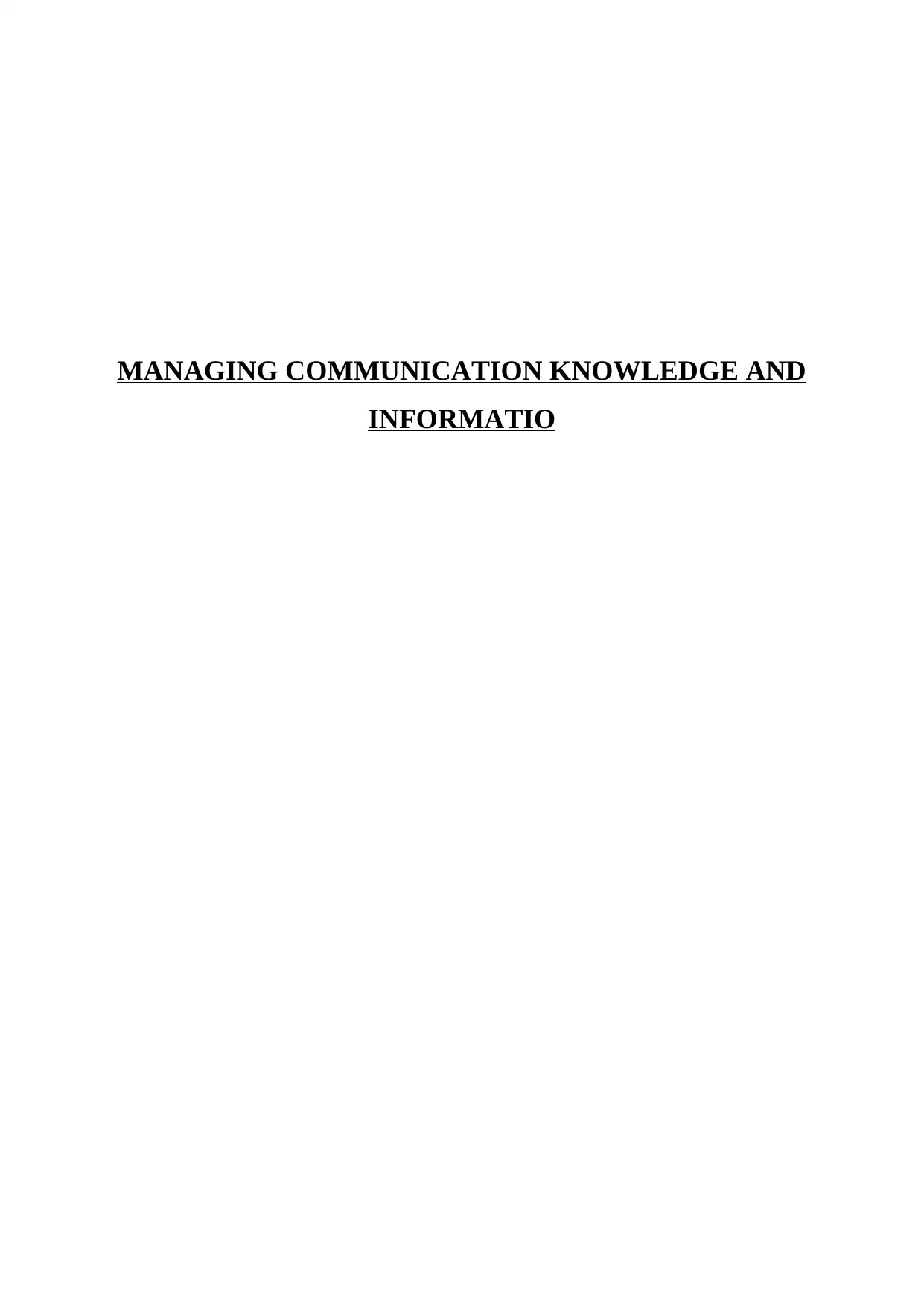
MANAGING COMMUNICATION KNOWLEDGE AND
INFORMATIO
INFORMATIO
Paraphrase This Document
Need a fresh take? Get an instant paraphrase of this document with our AI Paraphraser
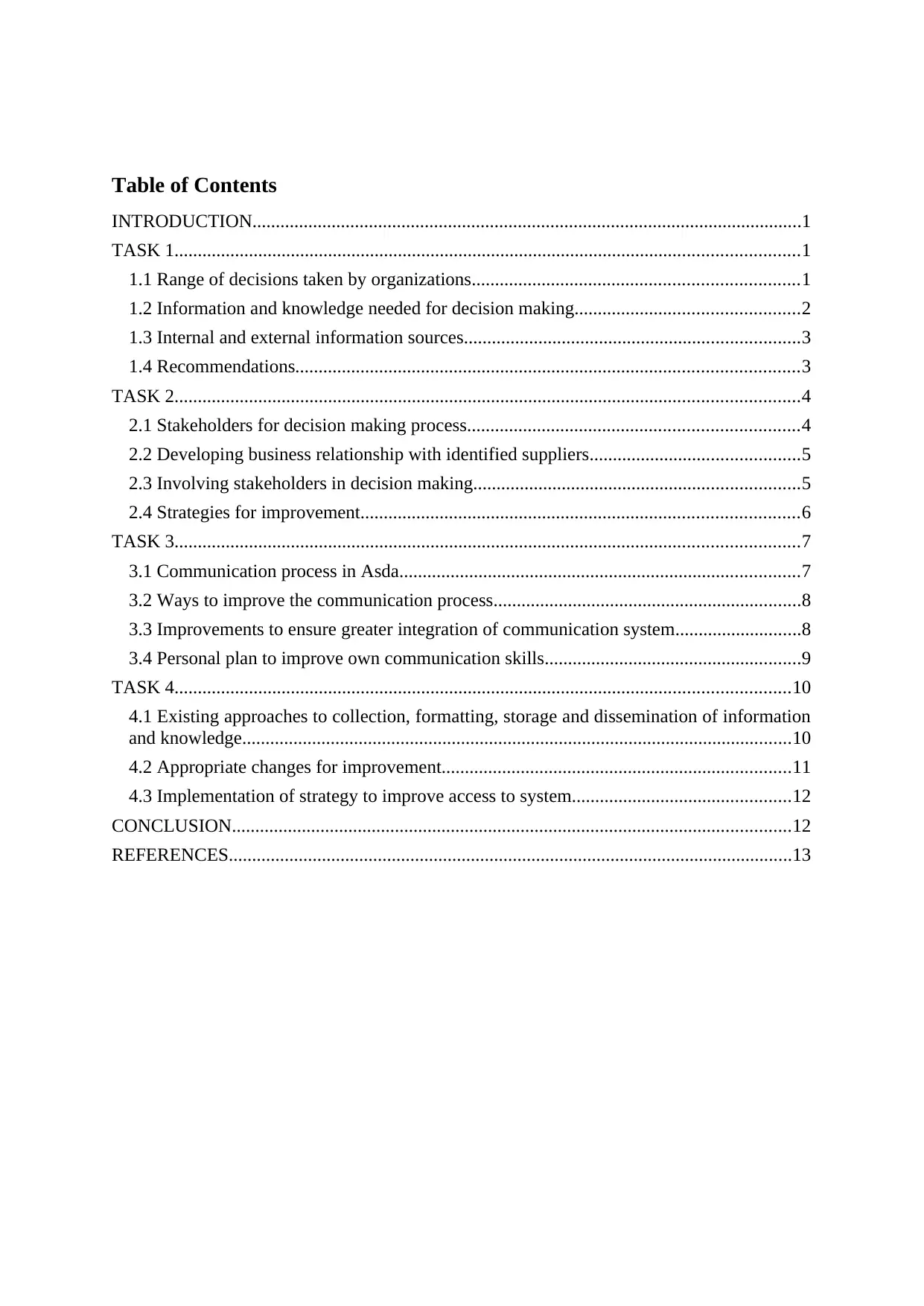
Table of Contents
INTRODUCTION......................................................................................................................1
TASK 1......................................................................................................................................1
1.1 Range of decisions taken by organizations......................................................................1
1.2 Information and knowledge needed for decision making................................................2
1.3 Internal and external information sources........................................................................3
1.4 Recommendations............................................................................................................3
TASK 2......................................................................................................................................4
2.1 Stakeholders for decision making process.......................................................................4
2.2 Developing business relationship with identified suppliers.............................................5
2.3 Involving stakeholders in decision making......................................................................5
2.4 Strategies for improvement..............................................................................................6
TASK 3......................................................................................................................................7
3.1 Communication process in Asda......................................................................................7
3.2 Ways to improve the communication process..................................................................8
3.3 Improvements to ensure greater integration of communication system...........................8
3.4 Personal plan to improve own communication skills.......................................................9
TASK 4....................................................................................................................................10
4.1 Existing approaches to collection, formatting, storage and dissemination of information
and knowledge......................................................................................................................10
4.2 Appropriate changes for improvement...........................................................................11
4.3 Implementation of strategy to improve access to system...............................................12
CONCLUSION........................................................................................................................12
REFERENCES.........................................................................................................................13
INTRODUCTION......................................................................................................................1
TASK 1......................................................................................................................................1
1.1 Range of decisions taken by organizations......................................................................1
1.2 Information and knowledge needed for decision making................................................2
1.3 Internal and external information sources........................................................................3
1.4 Recommendations............................................................................................................3
TASK 2......................................................................................................................................4
2.1 Stakeholders for decision making process.......................................................................4
2.2 Developing business relationship with identified suppliers.............................................5
2.3 Involving stakeholders in decision making......................................................................5
2.4 Strategies for improvement..............................................................................................6
TASK 3......................................................................................................................................7
3.1 Communication process in Asda......................................................................................7
3.2 Ways to improve the communication process..................................................................8
3.3 Improvements to ensure greater integration of communication system...........................8
3.4 Personal plan to improve own communication skills.......................................................9
TASK 4....................................................................................................................................10
4.1 Existing approaches to collection, formatting, storage and dissemination of information
and knowledge......................................................................................................................10
4.2 Appropriate changes for improvement...........................................................................11
4.3 Implementation of strategy to improve access to system...............................................12
CONCLUSION........................................................................................................................12
REFERENCES.........................................................................................................................13
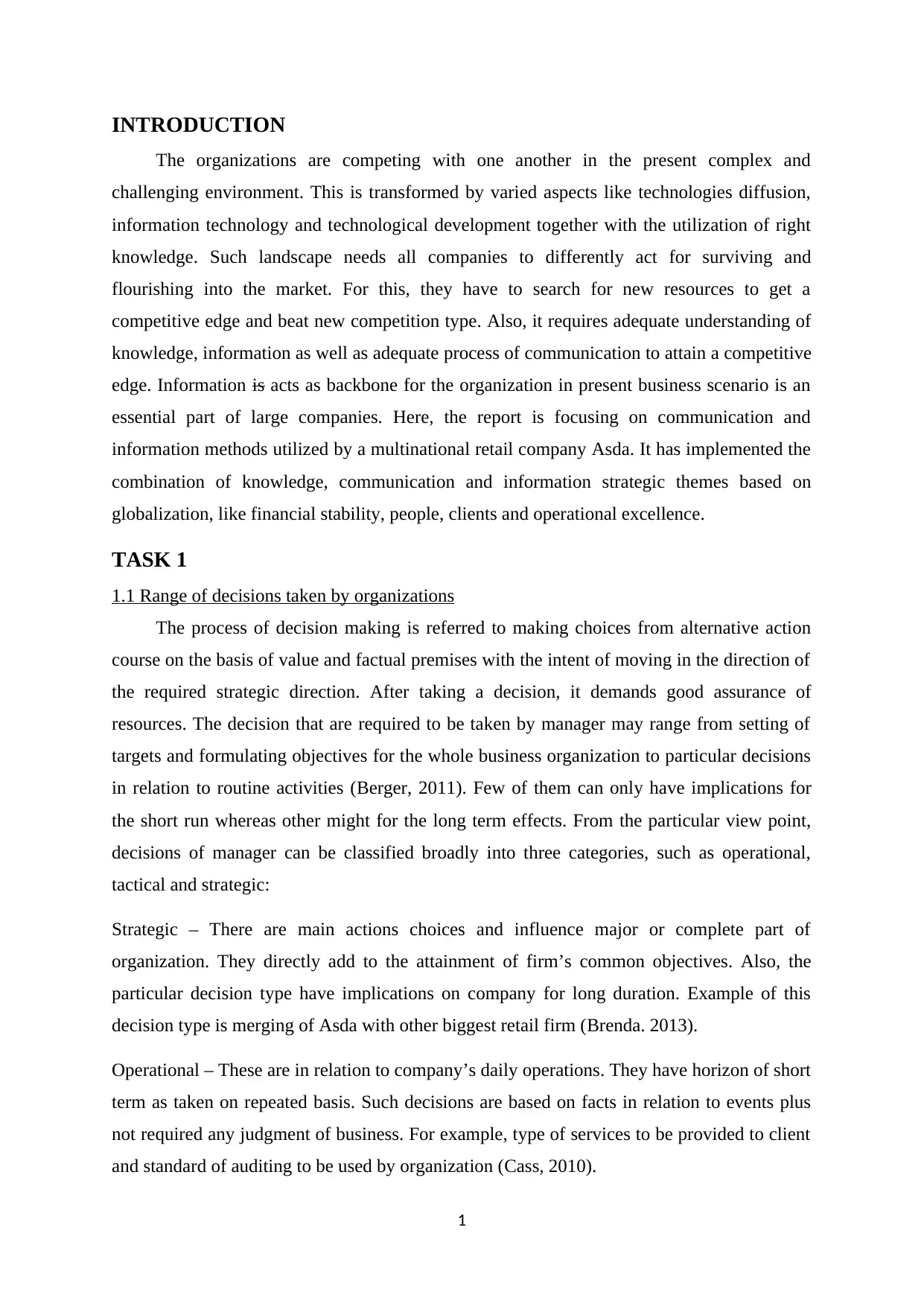
INTRODUCTION
The organizations are competing with one another in the present complex and
challenging environment. This is transformed by varied aspects like technologies diffusion,
information technology and technological development together with the utilization of right
knowledge. Such landscape needs all companies to differently act for surviving and
flourishing into the market. For this, they have to search for new resources to get a
competitive edge and beat new competition type. Also, it requires adequate understanding of
knowledge, information as well as adequate process of communication to attain a competitive
edge. Information is acts as backbone for the organization in present business scenario is an
essential part of large companies. Here, the report is focusing on communication and
information methods utilized by a multinational retail company Asda. It has implemented the
combination of knowledge, communication and information strategic themes based on
globalization, like financial stability, people, clients and operational excellence.
TASK 1
1.1 Range of decisions taken by organizations
The process of decision making is referred to making choices from alternative action
course on the basis of value and factual premises with the intent of moving in the direction of
the required strategic direction. After taking a decision, it demands good assurance of
resources. The decision that are required to be taken by manager may range from setting of
targets and formulating objectives for the whole business organization to particular decisions
in relation to routine activities (Berger, 2011). Few of them can only have implications for
the short run whereas other might for the long term effects. From the particular view point,
decisions of manager can be classified broadly into three categories, such as operational,
tactical and strategic:
Strategic – There are main actions choices and influence major or complete part of
organization. They directly add to the attainment of firm’s common objectives. Also, the
particular decision type have implications on company for long duration. Example of this
decision type is merging of Asda with other biggest retail firm (Brenda. 2013).
Operational – These are in relation to company’s daily operations. They have horizon of short
term as taken on repeated basis. Such decisions are based on facts in relation to events plus
not required any judgment of business. For example, type of services to be provided to client
and standard of auditing to be used by organization (Cass, 2010).
1
The organizations are competing with one another in the present complex and
challenging environment. This is transformed by varied aspects like technologies diffusion,
information technology and technological development together with the utilization of right
knowledge. Such landscape needs all companies to differently act for surviving and
flourishing into the market. For this, they have to search for new resources to get a
competitive edge and beat new competition type. Also, it requires adequate understanding of
knowledge, information as well as adequate process of communication to attain a competitive
edge. Information is acts as backbone for the organization in present business scenario is an
essential part of large companies. Here, the report is focusing on communication and
information methods utilized by a multinational retail company Asda. It has implemented the
combination of knowledge, communication and information strategic themes based on
globalization, like financial stability, people, clients and operational excellence.
TASK 1
1.1 Range of decisions taken by organizations
The process of decision making is referred to making choices from alternative action
course on the basis of value and factual premises with the intent of moving in the direction of
the required strategic direction. After taking a decision, it demands good assurance of
resources. The decision that are required to be taken by manager may range from setting of
targets and formulating objectives for the whole business organization to particular decisions
in relation to routine activities (Berger, 2011). Few of them can only have implications for
the short run whereas other might for the long term effects. From the particular view point,
decisions of manager can be classified broadly into three categories, such as operational,
tactical and strategic:
Strategic – There are main actions choices and influence major or complete part of
organization. They directly add to the attainment of firm’s common objectives. Also, the
particular decision type have implications on company for long duration. Example of this
decision type is merging of Asda with other biggest retail firm (Brenda. 2013).
Operational – These are in relation to company’s daily operations. They have horizon of short
term as taken on repeated basis. Such decisions are based on facts in relation to events plus
not required any judgment of business. For example, type of services to be provided to client
and standard of auditing to be used by organization (Cass, 2010).
1
⊘ This is a preview!⊘
Do you want full access?
Subscribe today to unlock all pages.

Trusted by 1+ million students worldwide
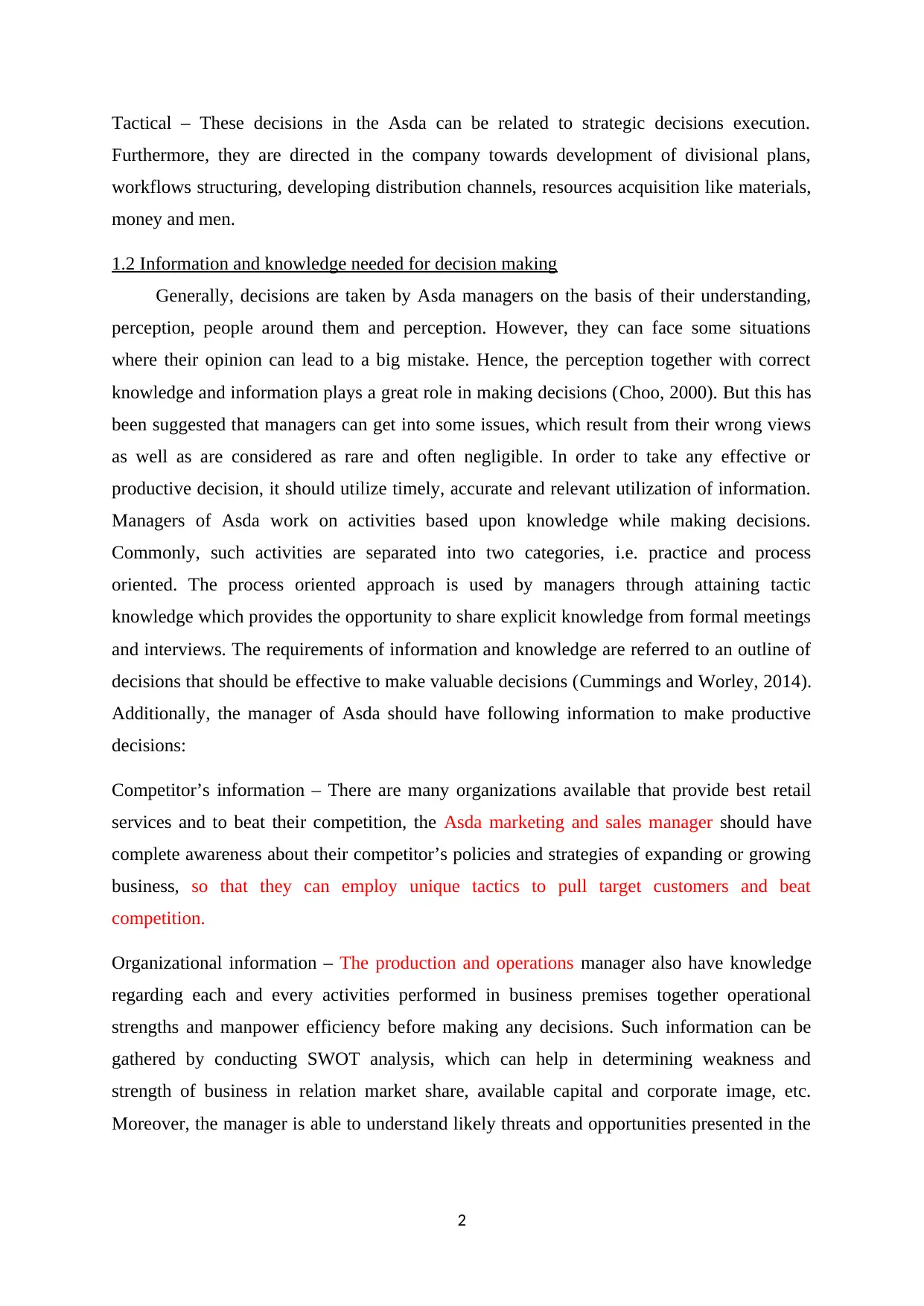
Tactical – These decisions in the Asda can be related to strategic decisions execution.
Furthermore, they are directed in the company towards development of divisional plans,
workflows structuring, developing distribution channels, resources acquisition like materials,
money and men.
1.2 Information and knowledge needed for decision making
Generally, decisions are taken by Asda managers on the basis of their understanding,
perception, people around them and perception. However, they can face some situations
where their opinion can lead to a big mistake. Hence, the perception together with correct
knowledge and information plays a great role in making decisions (Choo, 2000). But this has
been suggested that managers can get into some issues, which result from their wrong views
as well as are considered as rare and often negligible. In order to take any effective or
productive decision, it should utilize timely, accurate and relevant utilization of information.
Managers of Asda work on activities based upon knowledge while making decisions.
Commonly, such activities are separated into two categories, i.e. practice and process
oriented. The process oriented approach is used by managers through attaining tactic
knowledge which provides the opportunity to share explicit knowledge from formal meetings
and interviews. The requirements of information and knowledge are referred to an outline of
decisions that should be effective to make valuable decisions (Cummings and Worley, 2014).
Additionally, the manager of Asda should have following information to make productive
decisions:
Competitor’s information – There are many organizations available that provide best retail
services and to beat their competition, the Asda marketing and sales manager should have
complete awareness about their competitor’s policies and strategies of expanding or growing
business, so that they can employ unique tactics to pull target customers and beat
competition.
Organizational information – The production and operations manager also have knowledge
regarding each and every activities performed in business premises together operational
strengths and manpower efficiency before making any decisions. Such information can be
gathered by conducting SWOT analysis, which can help in determining weakness and
strength of business in relation market share, available capital and corporate image, etc.
Moreover, the manager is able to understand likely threats and opportunities presented in the
2
Furthermore, they are directed in the company towards development of divisional plans,
workflows structuring, developing distribution channels, resources acquisition like materials,
money and men.
1.2 Information and knowledge needed for decision making
Generally, decisions are taken by Asda managers on the basis of their understanding,
perception, people around them and perception. However, they can face some situations
where their opinion can lead to a big mistake. Hence, the perception together with correct
knowledge and information plays a great role in making decisions (Choo, 2000). But this has
been suggested that managers can get into some issues, which result from their wrong views
as well as are considered as rare and often negligible. In order to take any effective or
productive decision, it should utilize timely, accurate and relevant utilization of information.
Managers of Asda work on activities based upon knowledge while making decisions.
Commonly, such activities are separated into two categories, i.e. practice and process
oriented. The process oriented approach is used by managers through attaining tactic
knowledge which provides the opportunity to share explicit knowledge from formal meetings
and interviews. The requirements of information and knowledge are referred to an outline of
decisions that should be effective to make valuable decisions (Cummings and Worley, 2014).
Additionally, the manager of Asda should have following information to make productive
decisions:
Competitor’s information – There are many organizations available that provide best retail
services and to beat their competition, the Asda marketing and sales manager should have
complete awareness about their competitor’s policies and strategies of expanding or growing
business, so that they can employ unique tactics to pull target customers and beat
competition.
Organizational information – The production and operations manager also have knowledge
regarding each and every activities performed in business premises together operational
strengths and manpower efficiency before making any decisions. Such information can be
gathered by conducting SWOT analysis, which can help in determining weakness and
strength of business in relation market share, available capital and corporate image, etc.
Moreover, the manager is able to understand likely threats and opportunities presented in the
2
Paraphrase This Document
Need a fresh take? Get an instant paraphrase of this document with our AI Paraphraser

market (Edlund, 2015). This will enable them to design appropriate commodities and present
them in the stores.
Market information – For the new business development as well as to attain successful
outcomes, the R&D and marketing manager of Asda should have information regarding
target market and its customer’s wants. This can help the organization in manufacturing and
distributing commodities that are required by clients for fulfilling their satisfaction. Thus, can
lead to profitable outcomes for the corporation (Fernandez, Leidner and Leidner, 2014).
Decision makers require comprehensive information which should be accurate, timely,
reliable, pertinent and consistent so is useful to identify the extent of the issue, facilitate to
plan the resource allocation, monitor and thus affects the effectiveness of decision making.
1.3 Internal and external information sources
The internal information in an organization can be collected in following manner:
Personnel and administrative information – These informations are collected by HR manager
of Asda to plan remuneration and additional benefits for the employees. This also supports
the manager in deciding about essential training sessions for workers and estimate their
productivity rates to plan future business actions.
Marketing information – The marketing manager of Asda required to collect feedback from
customers for the company’s offerings. Their actual desires from the retail outlet and
consumption pattern. The marketing information also support the company in evaluating
sales and profits of its competitors and plan attractive strategies to lessen customer
complaints and increase the revenue (Hodge, 2011).
Financial information – Asda by having information about the performance of its profit and
loss can decide about employee’s salary, tax payable, and ways of recovering losses and
capital to be invested in new product development to grab the market share.
On the other hand, the organization can collect external information from sources like
private information providers, government agencies, etc. External information includes
professional publications, national opinion polls, legislation, census figures, industry
standards and trade journals. For Asda, important external information are related to its rivals
performance and activities (Maier, 2007).
1.4 Recommendations
According to Vroom and Yetton (1970), there are three decision making styles, such as:
3
them in the stores.
Market information – For the new business development as well as to attain successful
outcomes, the R&D and marketing manager of Asda should have information regarding
target market and its customer’s wants. This can help the organization in manufacturing and
distributing commodities that are required by clients for fulfilling their satisfaction. Thus, can
lead to profitable outcomes for the corporation (Fernandez, Leidner and Leidner, 2014).
Decision makers require comprehensive information which should be accurate, timely,
reliable, pertinent and consistent so is useful to identify the extent of the issue, facilitate to
plan the resource allocation, monitor and thus affects the effectiveness of decision making.
1.3 Internal and external information sources
The internal information in an organization can be collected in following manner:
Personnel and administrative information – These informations are collected by HR manager
of Asda to plan remuneration and additional benefits for the employees. This also supports
the manager in deciding about essential training sessions for workers and estimate their
productivity rates to plan future business actions.
Marketing information – The marketing manager of Asda required to collect feedback from
customers for the company’s offerings. Their actual desires from the retail outlet and
consumption pattern. The marketing information also support the company in evaluating
sales and profits of its competitors and plan attractive strategies to lessen customer
complaints and increase the revenue (Hodge, 2011).
Financial information – Asda by having information about the performance of its profit and
loss can decide about employee’s salary, tax payable, and ways of recovering losses and
capital to be invested in new product development to grab the market share.
On the other hand, the organization can collect external information from sources like
private information providers, government agencies, etc. External information includes
professional publications, national opinion polls, legislation, census figures, industry
standards and trade journals. For Asda, important external information are related to its rivals
performance and activities (Maier, 2007).
1.4 Recommendations
According to Vroom and Yetton (1970), there are three decision making styles, such as:
3
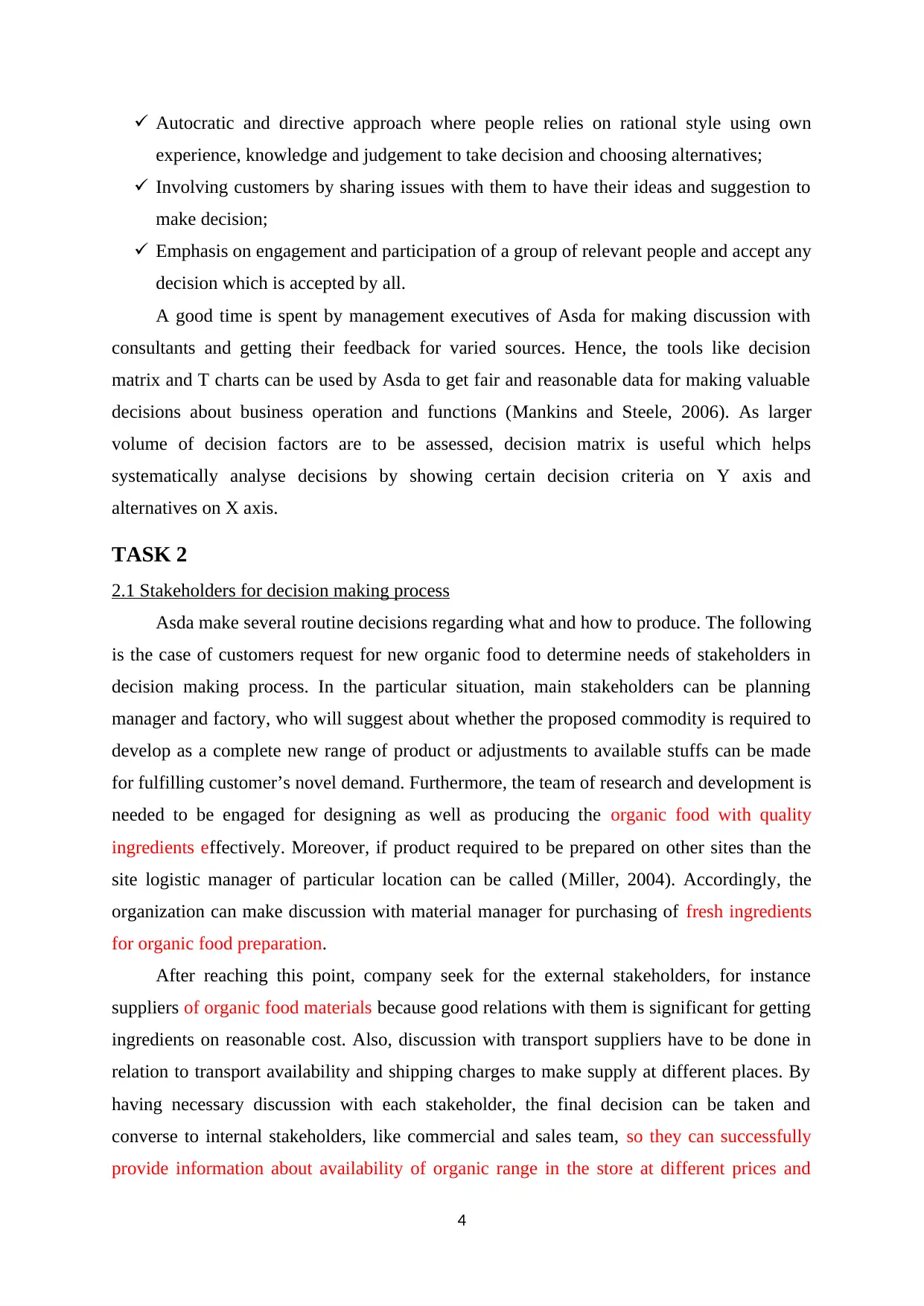
Autocratic and directive approach where people relies on rational style using own
experience, knowledge and judgement to take decision and choosing alternatives;
Involving customers by sharing issues with them to have their ideas and suggestion to
make decision;
Emphasis on engagement and participation of a group of relevant people and accept any
decision which is accepted by all.
A good time is spent by management executives of Asda for making discussion with
consultants and getting their feedback for varied sources. Hence, the tools like decision
matrix and T charts can be used by Asda to get fair and reasonable data for making valuable
decisions about business operation and functions (Mankins and Steele, 2006). As larger
volume of decision factors are to be assessed, decision matrix is useful which helps
systematically analyse decisions by showing certain decision criteria on Y axis and
alternatives on X axis.
TASK 2
2.1 Stakeholders for decision making process
Asda make several routine decisions regarding what and how to produce. The following
is the case of customers request for new organic food to determine needs of stakeholders in
decision making process. In the particular situation, main stakeholders can be planning
manager and factory, who will suggest about whether the proposed commodity is required to
develop as a complete new range of product or adjustments to available stuffs can be made
for fulfilling customer’s novel demand. Furthermore, the team of research and development is
needed to be engaged for designing as well as producing the organic food with quality
ingredients effectively. Moreover, if product required to be prepared on other sites than the
site logistic manager of particular location can be called (Miller, 2004). Accordingly, the
organization can make discussion with material manager for purchasing of fresh ingredients
for organic food preparation.
After reaching this point, company seek for the external stakeholders, for instance
suppliers of organic food materials because good relations with them is significant for getting
ingredients on reasonable cost. Also, discussion with transport suppliers have to be done in
relation to transport availability and shipping charges to make supply at different places. By
having necessary discussion with each stakeholder, the final decision can be taken and
converse to internal stakeholders, like commercial and sales team, so they can successfully
provide information about availability of organic range in the store at different prices and
4
experience, knowledge and judgement to take decision and choosing alternatives;
Involving customers by sharing issues with them to have their ideas and suggestion to
make decision;
Emphasis on engagement and participation of a group of relevant people and accept any
decision which is accepted by all.
A good time is spent by management executives of Asda for making discussion with
consultants and getting their feedback for varied sources. Hence, the tools like decision
matrix and T charts can be used by Asda to get fair and reasonable data for making valuable
decisions about business operation and functions (Mankins and Steele, 2006). As larger
volume of decision factors are to be assessed, decision matrix is useful which helps
systematically analyse decisions by showing certain decision criteria on Y axis and
alternatives on X axis.
TASK 2
2.1 Stakeholders for decision making process
Asda make several routine decisions regarding what and how to produce. The following
is the case of customers request for new organic food to determine needs of stakeholders in
decision making process. In the particular situation, main stakeholders can be planning
manager and factory, who will suggest about whether the proposed commodity is required to
develop as a complete new range of product or adjustments to available stuffs can be made
for fulfilling customer’s novel demand. Furthermore, the team of research and development is
needed to be engaged for designing as well as producing the organic food with quality
ingredients effectively. Moreover, if product required to be prepared on other sites than the
site logistic manager of particular location can be called (Miller, 2004). Accordingly, the
organization can make discussion with material manager for purchasing of fresh ingredients
for organic food preparation.
After reaching this point, company seek for the external stakeholders, for instance
suppliers of organic food materials because good relations with them is significant for getting
ingredients on reasonable cost. Also, discussion with transport suppliers have to be done in
relation to transport availability and shipping charges to make supply at different places. By
having necessary discussion with each stakeholder, the final decision can be taken and
converse to internal stakeholders, like commercial and sales team, so they can successfully
provide information about availability of organic range in the store at different prices and
4
⊘ This is a preview!⊘
Do you want full access?
Subscribe today to unlock all pages.

Trusted by 1+ million students worldwide
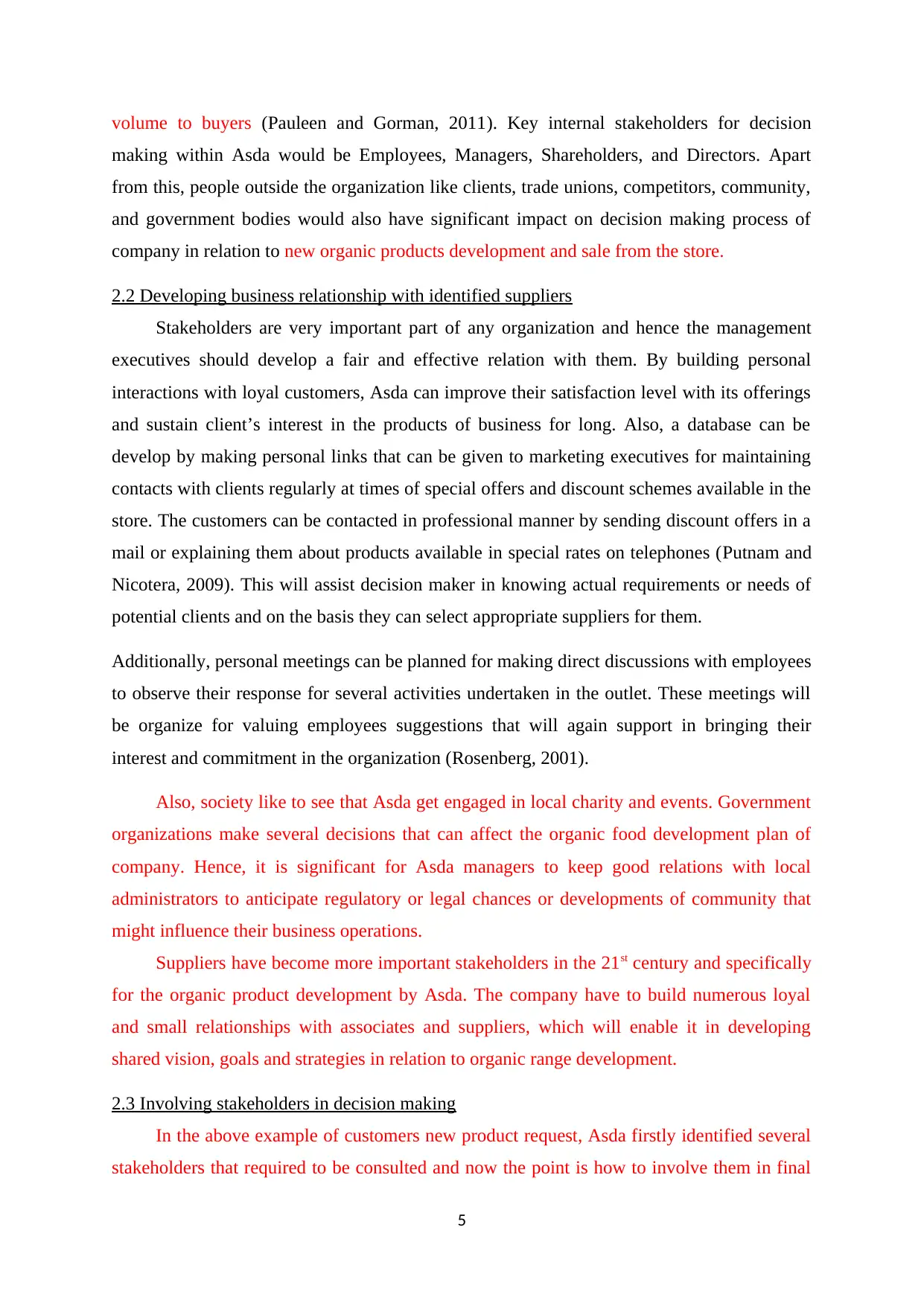
volume to buyers (Pauleen and Gorman, 2011). Key internal stakeholders for decision
making within Asda would be Employees, Managers, Shareholders, and Directors. Apart
from this, people outside the organization like clients, trade unions, competitors, community,
and government bodies would also have significant impact on decision making process of
company in relation to new organic products development and sale from the store.
2.2 Developing business relationship with identified suppliers
Stakeholders are very important part of any organization and hence the management
executives should develop a fair and effective relation with them. By building personal
interactions with loyal customers, Asda can improve their satisfaction level with its offerings
and sustain client’s interest in the products of business for long. Also, a database can be
develop by making personal links that can be given to marketing executives for maintaining
contacts with clients regularly at times of special offers and discount schemes available in the
store. The customers can be contacted in professional manner by sending discount offers in a
mail or explaining them about products available in special rates on telephones (Putnam and
Nicotera, 2009). This will assist decision maker in knowing actual requirements or needs of
potential clients and on the basis they can select appropriate suppliers for them.
Additionally, personal meetings can be planned for making direct discussions with employees
to observe their response for several activities undertaken in the outlet. These meetings will
be organize for valuing employees suggestions that will again support in bringing their
interest and commitment in the organization (Rosenberg, 2001).
Also, society like to see that Asda get engaged in local charity and events. Government
organizations make several decisions that can affect the organic food development plan of
company. Hence, it is significant for Asda managers to keep good relations with local
administrators to anticipate regulatory or legal chances or developments of community that
might influence their business operations.
Suppliers have become more important stakeholders in the 21st century and specifically
for the organic product development by Asda. The company have to build numerous loyal
and small relationships with associates and suppliers, which will enable it in developing
shared vision, goals and strategies in relation to organic range development.
2.3 Involving stakeholders in decision making
In the above example of customers new product request, Asda firstly identified several
stakeholders that required to be consulted and now the point is how to involve them in final
5
making within Asda would be Employees, Managers, Shareholders, and Directors. Apart
from this, people outside the organization like clients, trade unions, competitors, community,
and government bodies would also have significant impact on decision making process of
company in relation to new organic products development and sale from the store.
2.2 Developing business relationship with identified suppliers
Stakeholders are very important part of any organization and hence the management
executives should develop a fair and effective relation with them. By building personal
interactions with loyal customers, Asda can improve their satisfaction level with its offerings
and sustain client’s interest in the products of business for long. Also, a database can be
develop by making personal links that can be given to marketing executives for maintaining
contacts with clients regularly at times of special offers and discount schemes available in the
store. The customers can be contacted in professional manner by sending discount offers in a
mail or explaining them about products available in special rates on telephones (Putnam and
Nicotera, 2009). This will assist decision maker in knowing actual requirements or needs of
potential clients and on the basis they can select appropriate suppliers for them.
Additionally, personal meetings can be planned for making direct discussions with employees
to observe their response for several activities undertaken in the outlet. These meetings will
be organize for valuing employees suggestions that will again support in bringing their
interest and commitment in the organization (Rosenberg, 2001).
Also, society like to see that Asda get engaged in local charity and events. Government
organizations make several decisions that can affect the organic food development plan of
company. Hence, it is significant for Asda managers to keep good relations with local
administrators to anticipate regulatory or legal chances or developments of community that
might influence their business operations.
Suppliers have become more important stakeholders in the 21st century and specifically
for the organic product development by Asda. The company have to build numerous loyal
and small relationships with associates and suppliers, which will enable it in developing
shared vision, goals and strategies in relation to organic range development.
2.3 Involving stakeholders in decision making
In the above example of customers new product request, Asda firstly identified several
stakeholders that required to be consulted and now the point is how to involve them in final
5
Paraphrase This Document
Need a fresh take? Get an instant paraphrase of this document with our AI Paraphraser
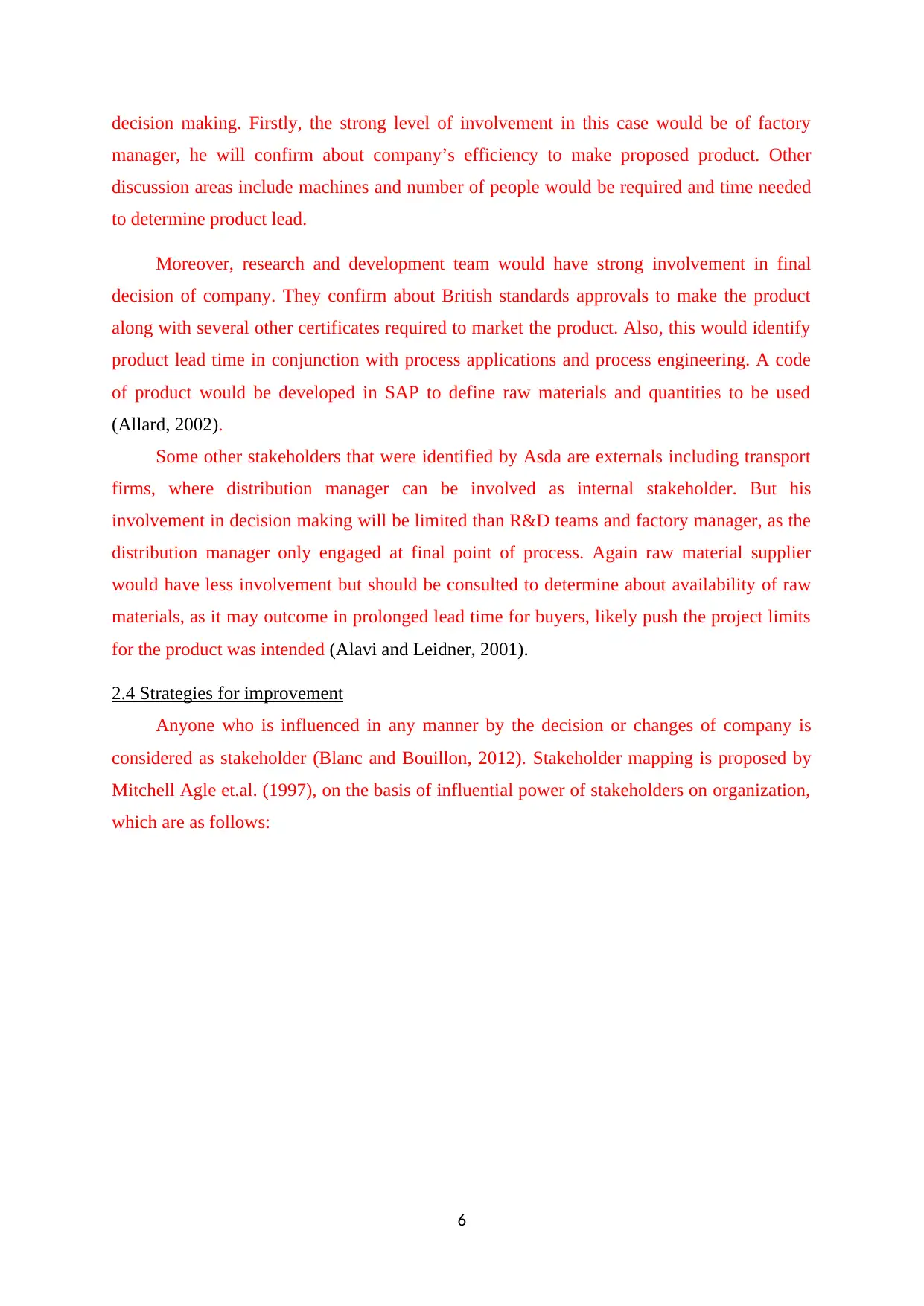
decision making. Firstly, the strong level of involvement in this case would be of factory
manager, he will confirm about company’s efficiency to make proposed product. Other
discussion areas include machines and number of people would be required and time needed
to determine product lead.
Moreover, research and development team would have strong involvement in final
decision of company. They confirm about British standards approvals to make the product
along with several other certificates required to market the product. Also, this would identify
product lead time in conjunction with process applications and process engineering. A code
of product would be developed in SAP to define raw materials and quantities to be used
(Allard, 2002).
Some other stakeholders that were identified by Asda are externals including transport
firms, where distribution manager can be involved as internal stakeholder. But his
involvement in decision making will be limited than R&D teams and factory manager, as the
distribution manager only engaged at final point of process. Again raw material supplier
would have less involvement but should be consulted to determine about availability of raw
materials, as it may outcome in prolonged lead time for buyers, likely push the project limits
for the product was intended (Alavi and Leidner, 2001).
2.4 Strategies for improvement
Anyone who is influenced in any manner by the decision or changes of company is
considered as stakeholder (Blanc and Bouillon, 2012). Stakeholder mapping is proposed by
Mitchell Agle et.al. (1997), on the basis of influential power of stakeholders on organization,
which are as follows:
6
manager, he will confirm about company’s efficiency to make proposed product. Other
discussion areas include machines and number of people would be required and time needed
to determine product lead.
Moreover, research and development team would have strong involvement in final
decision of company. They confirm about British standards approvals to make the product
along with several other certificates required to market the product. Also, this would identify
product lead time in conjunction with process applications and process engineering. A code
of product would be developed in SAP to define raw materials and quantities to be used
(Allard, 2002).
Some other stakeholders that were identified by Asda are externals including transport
firms, where distribution manager can be involved as internal stakeholder. But his
involvement in decision making will be limited than R&D teams and factory manager, as the
distribution manager only engaged at final point of process. Again raw material supplier
would have less involvement but should be consulted to determine about availability of raw
materials, as it may outcome in prolonged lead time for buyers, likely push the project limits
for the product was intended (Alavi and Leidner, 2001).
2.4 Strategies for improvement
Anyone who is influenced in any manner by the decision or changes of company is
considered as stakeholder (Blanc and Bouillon, 2012). Stakeholder mapping is proposed by
Mitchell Agle et.al. (1997), on the basis of influential power of stakeholders on organization,
which are as follows:
6
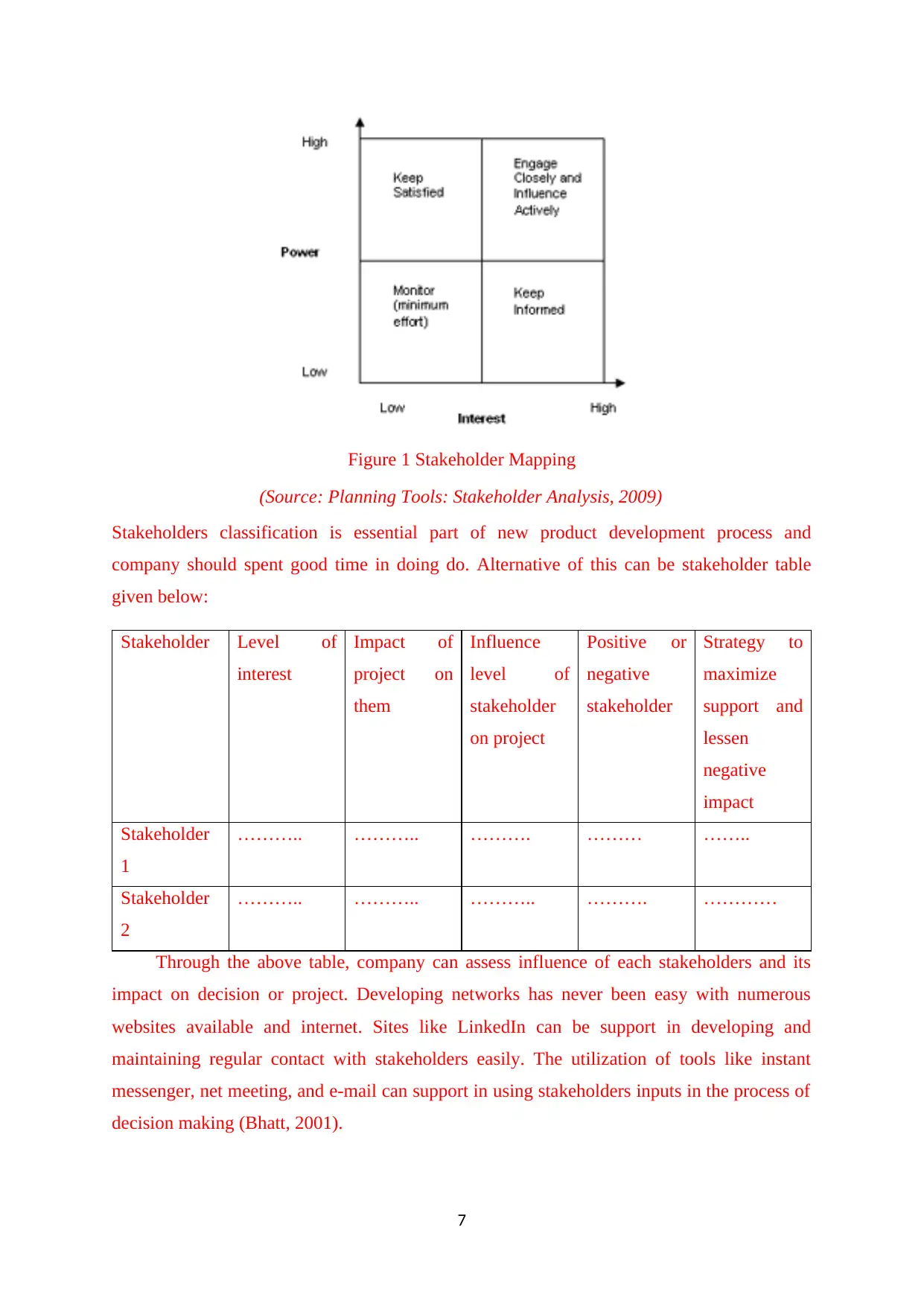
Figure 1 Stakeholder Mapping
(Source: Planning Tools: Stakeholder Analysis, 2009)
Stakeholders classification is essential part of new product development process and
company should spent good time in doing do. Alternative of this can be stakeholder table
given below:
Stakeholder Level of
interest
Impact of
project on
them
Influence
level of
stakeholder
on project
Positive or
negative
stakeholder
Strategy to
maximize
support and
lessen
negative
impact
Stakeholder
1
……….. ……….. ………. ……… ……..
Stakeholder
2
……….. ……….. ……….. ………. …………
Through the above table, company can assess influence of each stakeholders and its
impact on decision or project. Developing networks has never been easy with numerous
websites available and internet. Sites like LinkedIn can be support in developing and
maintaining regular contact with stakeholders easily. The utilization of tools like instant
messenger, net meeting, and e-mail can support in using stakeholders inputs in the process of
decision making (Bhatt, 2001).
7
(Source: Planning Tools: Stakeholder Analysis, 2009)
Stakeholders classification is essential part of new product development process and
company should spent good time in doing do. Alternative of this can be stakeholder table
given below:
Stakeholder Level of
interest
Impact of
project on
them
Influence
level of
stakeholder
on project
Positive or
negative
stakeholder
Strategy to
maximize
support and
lessen
negative
impact
Stakeholder
1
……….. ……….. ………. ……… ……..
Stakeholder
2
……….. ……….. ……….. ………. …………
Through the above table, company can assess influence of each stakeholders and its
impact on decision or project. Developing networks has never been easy with numerous
websites available and internet. Sites like LinkedIn can be support in developing and
maintaining regular contact with stakeholders easily. The utilization of tools like instant
messenger, net meeting, and e-mail can support in using stakeholders inputs in the process of
decision making (Bhatt, 2001).
7
⊘ This is a preview!⊘
Do you want full access?
Subscribe today to unlock all pages.

Trusted by 1+ million students worldwide
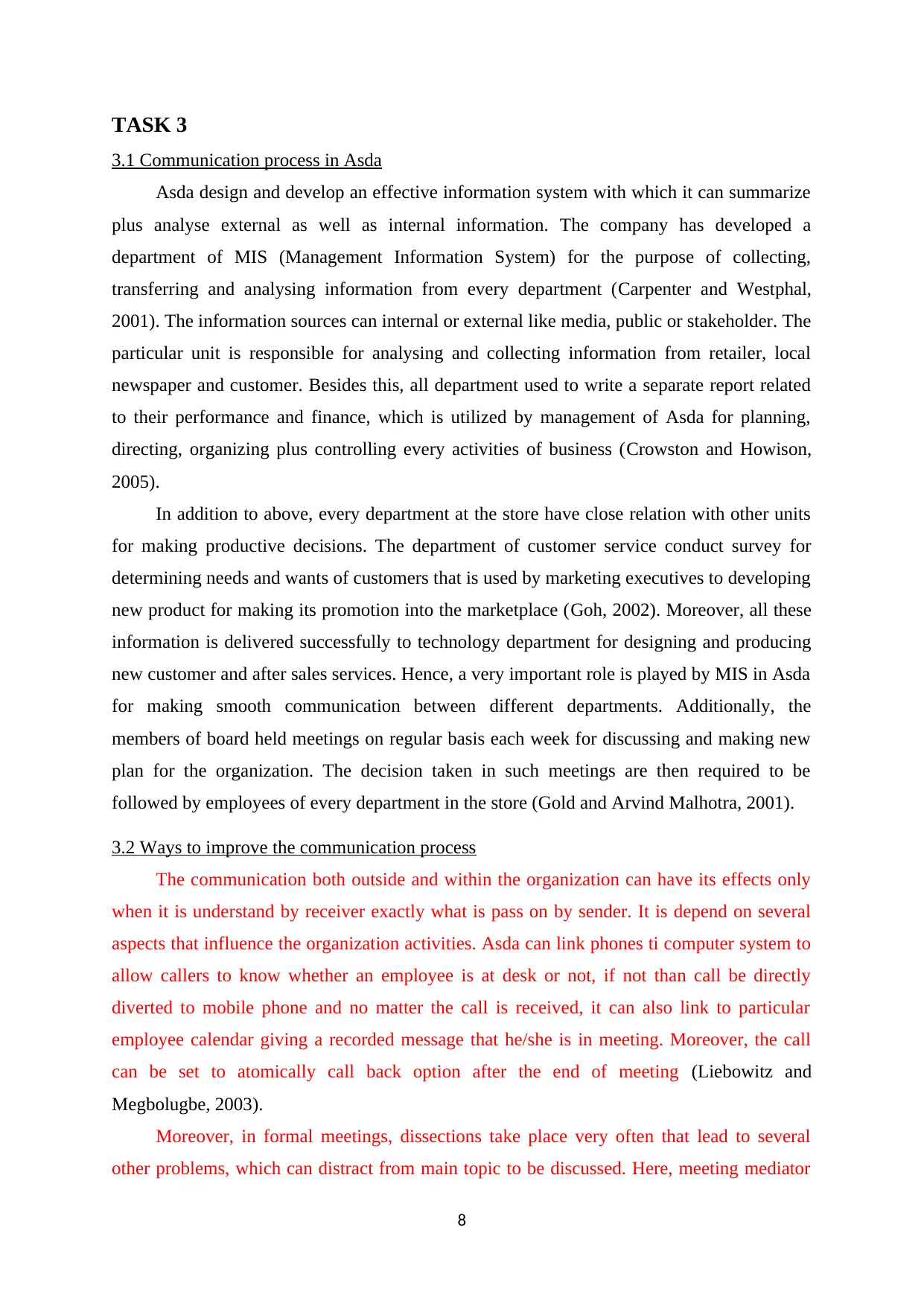
TASK 3
3.1 Communication process in Asda
Asda design and develop an effective information system with which it can summarize
plus analyse external as well as internal information. The company has developed a
department of MIS (Management Information System) for the purpose of collecting,
transferring and analysing information from every department (Carpenter and Westphal,
2001). The information sources can internal or external like media, public or stakeholder. The
particular unit is responsible for analysing and collecting information from retailer, local
newspaper and customer. Besides this, all department used to write a separate report related
to their performance and finance, which is utilized by management of Asda for planning,
directing, organizing plus controlling every activities of business (Crowston and Howison,
2005).
In addition to above, every department at the store have close relation with other units
for making productive decisions. The department of customer service conduct survey for
determining needs and wants of customers that is used by marketing executives to developing
new product for making its promotion into the marketplace (Goh, 2002). Moreover, all these
information is delivered successfully to technology department for designing and producing
new customer and after sales services. Hence, a very important role is played by MIS in Asda
for making smooth communication between different departments. Additionally, the
members of board held meetings on regular basis each week for discussing and making new
plan for the organization. The decision taken in such meetings are then required to be
followed by employees of every department in the store (Gold and Arvind Malhotra, 2001).
3.2 Ways to improve the communication process
The communication both outside and within the organization can have its effects only
when it is understand by receiver exactly what is pass on by sender. It is depend on several
aspects that influence the organization activities. Asda can link phones ti computer system to
allow callers to know whether an employee is at desk or not, if not than call be directly
diverted to mobile phone and no matter the call is received, it can also link to particular
employee calendar giving a recorded message that he/she is in meeting. Moreover, the call
can be set to atomically call back option after the end of meeting (Liebowitz and
Megbolugbe, 2003).
Moreover, in formal meetings, dissections take place very often that lead to several
other problems, which can distract from main topic to be discussed. Here, meeting mediator
8
3.1 Communication process in Asda
Asda design and develop an effective information system with which it can summarize
plus analyse external as well as internal information. The company has developed a
department of MIS (Management Information System) for the purpose of collecting,
transferring and analysing information from every department (Carpenter and Westphal,
2001). The information sources can internal or external like media, public or stakeholder. The
particular unit is responsible for analysing and collecting information from retailer, local
newspaper and customer. Besides this, all department used to write a separate report related
to their performance and finance, which is utilized by management of Asda for planning,
directing, organizing plus controlling every activities of business (Crowston and Howison,
2005).
In addition to above, every department at the store have close relation with other units
for making productive decisions. The department of customer service conduct survey for
determining needs and wants of customers that is used by marketing executives to developing
new product for making its promotion into the marketplace (Goh, 2002). Moreover, all these
information is delivered successfully to technology department for designing and producing
new customer and after sales services. Hence, a very important role is played by MIS in Asda
for making smooth communication between different departments. Additionally, the
members of board held meetings on regular basis each week for discussing and making new
plan for the organization. The decision taken in such meetings are then required to be
followed by employees of every department in the store (Gold and Arvind Malhotra, 2001).
3.2 Ways to improve the communication process
The communication both outside and within the organization can have its effects only
when it is understand by receiver exactly what is pass on by sender. It is depend on several
aspects that influence the organization activities. Asda can link phones ti computer system to
allow callers to know whether an employee is at desk or not, if not than call be directly
diverted to mobile phone and no matter the call is received, it can also link to particular
employee calendar giving a recorded message that he/she is in meeting. Moreover, the call
can be set to atomically call back option after the end of meeting (Liebowitz and
Megbolugbe, 2003).
Moreover, in formal meetings, dissections take place very often that lead to several
other problems, which can distract from main topic to be discussed. Here, meeting mediator
8
Paraphrase This Document
Need a fresh take? Get an instant paraphrase of this document with our AI Paraphraser
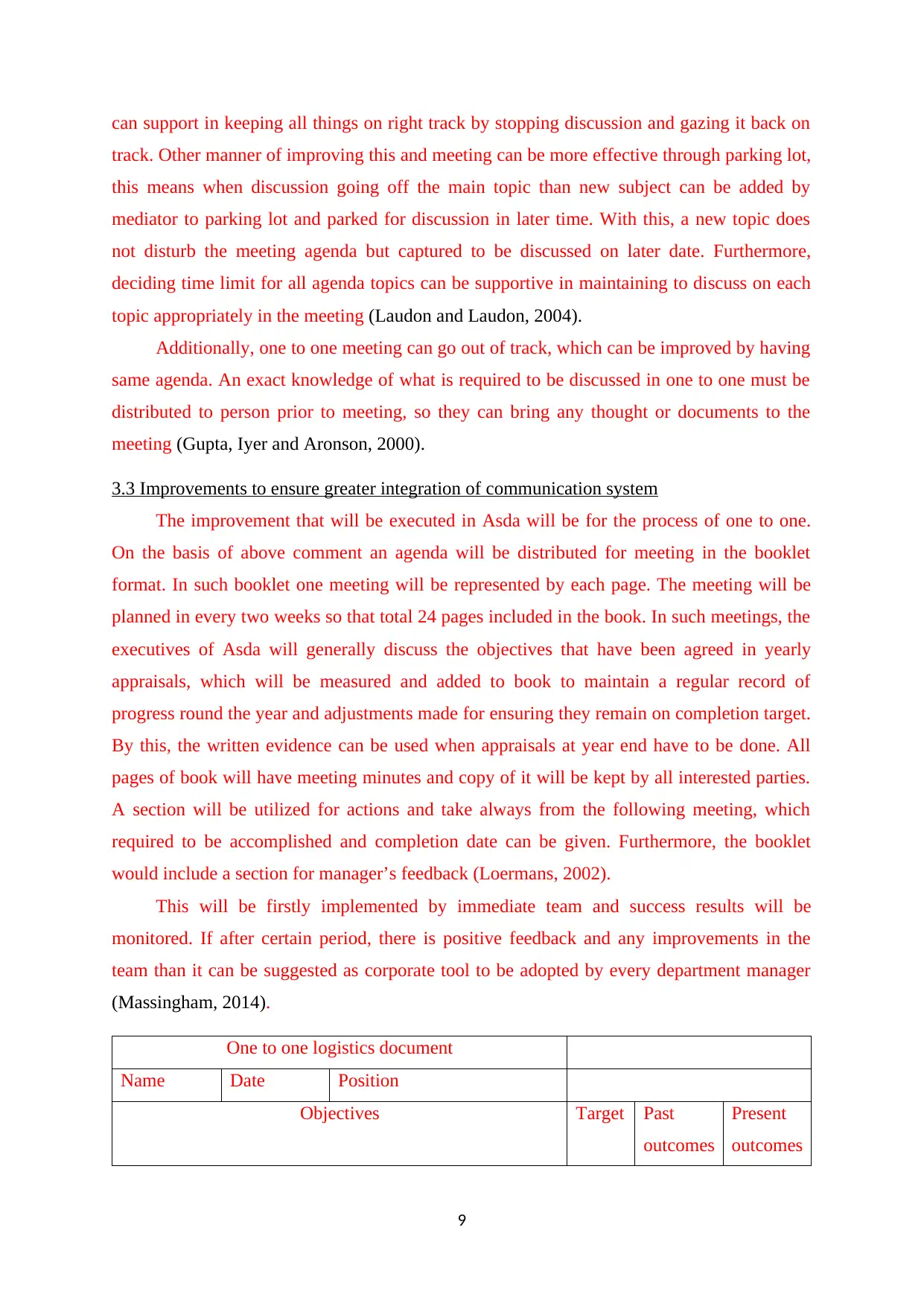
can support in keeping all things on right track by stopping discussion and gazing it back on
track. Other manner of improving this and meeting can be more effective through parking lot,
this means when discussion going off the main topic than new subject can be added by
mediator to parking lot and parked for discussion in later time. With this, a new topic does
not disturb the meeting agenda but captured to be discussed on later date. Furthermore,
deciding time limit for all agenda topics can be supportive in maintaining to discuss on each
topic appropriately in the meeting (Laudon and Laudon, 2004).
Additionally, one to one meeting can go out of track, which can be improved by having
same agenda. An exact knowledge of what is required to be discussed in one to one must be
distributed to person prior to meeting, so they can bring any thought or documents to the
meeting (Gupta, Iyer and Aronson, 2000).
3.3 Improvements to ensure greater integration of communication system
The improvement that will be executed in Asda will be for the process of one to one.
On the basis of above comment an agenda will be distributed for meeting in the booklet
format. In such booklet one meeting will be represented by each page. The meeting will be
planned in every two weeks so that total 24 pages included in the book. In such meetings, the
executives of Asda will generally discuss the objectives that have been agreed in yearly
appraisals, which will be measured and added to book to maintain a regular record of
progress round the year and adjustments made for ensuring they remain on completion target.
By this, the written evidence can be used when appraisals at year end have to be done. All
pages of book will have meeting minutes and copy of it will be kept by all interested parties.
A section will be utilized for actions and take always from the following meeting, which
required to be accomplished and completion date can be given. Furthermore, the booklet
would include a section for manager’s feedback (Loermans, 2002).
This will be firstly implemented by immediate team and success results will be
monitored. If after certain period, there is positive feedback and any improvements in the
team than it can be suggested as corporate tool to be adopted by every department manager
(Massingham, 2014).
One to one logistics document
Name Date Position
Objectives Target Past
outcomes
Present
outcomes
9
track. Other manner of improving this and meeting can be more effective through parking lot,
this means when discussion going off the main topic than new subject can be added by
mediator to parking lot and parked for discussion in later time. With this, a new topic does
not disturb the meeting agenda but captured to be discussed on later date. Furthermore,
deciding time limit for all agenda topics can be supportive in maintaining to discuss on each
topic appropriately in the meeting (Laudon and Laudon, 2004).
Additionally, one to one meeting can go out of track, which can be improved by having
same agenda. An exact knowledge of what is required to be discussed in one to one must be
distributed to person prior to meeting, so they can bring any thought or documents to the
meeting (Gupta, Iyer and Aronson, 2000).
3.3 Improvements to ensure greater integration of communication system
The improvement that will be executed in Asda will be for the process of one to one.
On the basis of above comment an agenda will be distributed for meeting in the booklet
format. In such booklet one meeting will be represented by each page. The meeting will be
planned in every two weeks so that total 24 pages included in the book. In such meetings, the
executives of Asda will generally discuss the objectives that have been agreed in yearly
appraisals, which will be measured and added to book to maintain a regular record of
progress round the year and adjustments made for ensuring they remain on completion target.
By this, the written evidence can be used when appraisals at year end have to be done. All
pages of book will have meeting minutes and copy of it will be kept by all interested parties.
A section will be utilized for actions and take always from the following meeting, which
required to be accomplished and completion date can be given. Furthermore, the booklet
would include a section for manager’s feedback (Loermans, 2002).
This will be firstly implemented by immediate team and success results will be
monitored. If after certain period, there is positive feedback and any improvements in the
team than it can be suggested as corporate tool to be adopted by every department manager
(Massingham, 2014).
One to one logistics document
Name Date Position
Objectives Target Past
outcomes
Present
outcomes
9
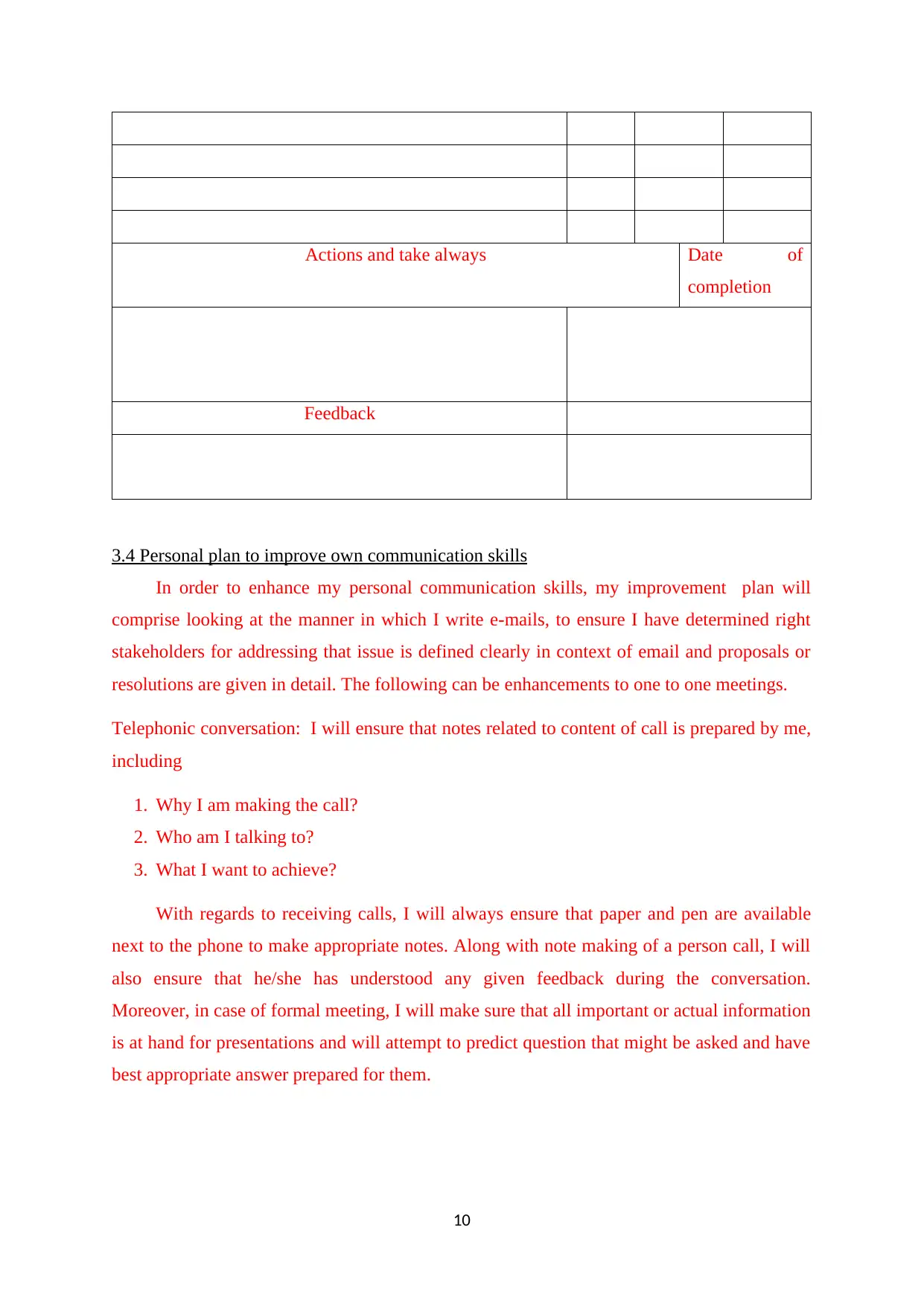
Actions and take always Date of
completion
Feedback
3.4 Personal plan to improve own communication skills
In order to enhance my personal communication skills, my improvement plan will
comprise looking at the manner in which I write e-mails, to ensure I have determined right
stakeholders for addressing that issue is defined clearly in context of email and proposals or
resolutions are given in detail. The following can be enhancements to one to one meetings.
Telephonic conversation: I will ensure that notes related to content of call is prepared by me,
including
1. Why I am making the call?
2. Who am I talking to?
3. What I want to achieve?
With regards to receiving calls, I will always ensure that paper and pen are available
next to the phone to make appropriate notes. Along with note making of a person call, I will
also ensure that he/she has understood any given feedback during the conversation.
Moreover, in case of formal meeting, I will make sure that all important or actual information
is at hand for presentations and will attempt to predict question that might be asked and have
best appropriate answer prepared for them.
10
completion
Feedback
3.4 Personal plan to improve own communication skills
In order to enhance my personal communication skills, my improvement plan will
comprise looking at the manner in which I write e-mails, to ensure I have determined right
stakeholders for addressing that issue is defined clearly in context of email and proposals or
resolutions are given in detail. The following can be enhancements to one to one meetings.
Telephonic conversation: I will ensure that notes related to content of call is prepared by me,
including
1. Why I am making the call?
2. Who am I talking to?
3. What I want to achieve?
With regards to receiving calls, I will always ensure that paper and pen are available
next to the phone to make appropriate notes. Along with note making of a person call, I will
also ensure that he/she has understood any given feedback during the conversation.
Moreover, in case of formal meeting, I will make sure that all important or actual information
is at hand for presentations and will attempt to predict question that might be asked and have
best appropriate answer prepared for them.
10
⊘ This is a preview!⊘
Do you want full access?
Subscribe today to unlock all pages.

Trusted by 1+ million students worldwide
1 out of 17
Related Documents
Your All-in-One AI-Powered Toolkit for Academic Success.
+13062052269
info@desklib.com
Available 24*7 on WhatsApp / Email
![[object Object]](/_next/static/media/star-bottom.7253800d.svg)
Unlock your academic potential
Copyright © 2020–2025 A2Z Services. All Rights Reserved. Developed and managed by ZUCOL.





